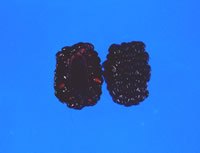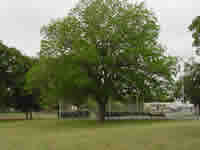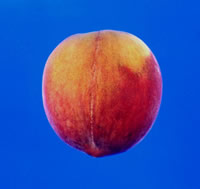FRUIT AND NUT CROP DECISIONS
by Jerry Parsons, Ph.D.
Horticulture Specialist, Texas Agricultural Extension Service
in San Antonio
This is the best time of the year to buy fruit
and nut trees. New shipments of freshly dug plants have arrived,
the best varieties are now available and trees are as cheap
as they will be all year.
But, can you really expect success if you plant
a fruit or nut tree? Or, maybe a more accurate question --
are you willing to do the work required to insure production?
And, most importantly, do you have a suitable location in
which to plant? These questions need to be resolved BEFORE
you make the purchase. Otherwise you will likely be disappointed,
as well as waste a valuable resource --the grafted plant.
For maximum production, fruit plants need at
least 8 hours of full (where you could sunbathe) sunlight
daily. If you moved to the country for beautiful live oak
scenery and shade, don't expect fruit and nut trees to do
well under those big foliaged beauties. Extremely shaded landscapes
ARE NOT SUITABLE sites for fruit planting. The trees may survive
but they won't be productive. Remember the sun is the source
of all energy for plant growth. Green plants have the unique
ability to take light energy, along with carbon dioxide from
the air and water, and convert it into organic compounds through
a complex process known as photosynthesis. So anything less
than full sunlight will result in a reduced performance by
the tree. Many times trees have adequate light when they are
small but as they get larger they compete for not only sunlight
but water and nutrients as well.
Water is the mainstay of life for all organisms.
Fruit plants are no exception. Water provides the turgor pressure
for cells to expand and thus "grow". Established
plants harvest water from the soil reservoir - the better
the reservoir the better the plants will do - plus they use
the water you provide. Water management is much more critical
on poor soils than on deep soils.
 A
good rule of thumb is one to two inches of water per week
during the growing season. Since oxygen is needed in the soil
in order for plants to take up the water, don't saturate the
soil. Also, the best roots are in the top four to six inches
of the soil because this is where the greatest oxygen levels
are. The effective root zone on most plants is only about
24 to 32 inches deep and if the soils are shallower - then
it is less. This means once the water goes below two feet
- it is much harder for the plant to use. So the trick is
not to let the water run longer in a spot but rather to wet
more soil volume. The poorer the soil - the greater the volume
of soil which needs to be wetted for maximum plant performance.
A
good rule of thumb is one to two inches of water per week
during the growing season. Since oxygen is needed in the soil
in order for plants to take up the water, don't saturate the
soil. Also, the best roots are in the top four to six inches
of the soil because this is where the greatest oxygen levels
are. The effective root zone on most plants is only about
24 to 32 inches deep and if the soils are shallower - then
it is less. This means once the water goes below two feet
- it is much harder for the plant to use. So the trick is
not to let the water run longer in a spot but rather to wet
more soil volume. The poorer the soil - the greater the volume
of soil which needs to be wetted for maximum plant performance.
Soil and drainage are important considerations.
There is no question that soil is the number one factor that
determines the success or failure of a planting if located
in full sun. Some soils are so good that the trees grow in
spite of what you do.
The soil profile serves three main functions:
holding the plant upright, a source of nutrients, and a water
reservoir. Some soils are naturally high in fertility with
a high water holding capacity. Fruit plants are naturally
going to do much better in those areas than in poor soils.
Fruit plants require well drained soil in order
to grow and produce. Ideally you should have a minimum of
12 - 18 inches of soil; if you have less you may want to consider
building a raised bed. Most fruit and nut species cannot tolerate
excessive periods of "wet feet." Fruit and nut trees
planted in soil with poor soil drainage show reduced growth,
pale green leaves, zinc rosette (on pecans), iron chlorosis,
leaf abscission, and drought stress in most instances. These
symptoms are brought about by the plants inability to pick
up nutrients and water from the soil.
For nutrients and water to enter the plant,
oxygen must be adjacent to the root. If oxygen is not available
in the soil, the plant will be unable to absorb essential
nutrients necessary for growth. In some instances the plant
will not be able to absorb water even while standing in water.
To evaluate soil drainage, try digging a hole 32 inches deep
and 8 inches in diameter. Fill it with 7 gallons of water.
The hole should drain in less than 48 hours. If the hole is
empty in 1 hour, your site has excellent internal drainage.
There is very good internal drainage if it is empty in 8 hours.
There is good internal drainage if it is empty in 24 hours
and adequate internal drainage if empty in 48 hours. If at
the end of 48 hours the hole still has any water, it will
be extremely difficult to produce regular crops (especially
pecans) in this soil.
 All
fruit crops do best in soils with excellent soil drainage.
Peaches and plums need very good soil drainage; apples, pears
and grapes need good soil drainage; pecans, figs and persimmons
can survive with adequate soil drainage.
All
fruit crops do best in soils with excellent soil drainage.
Peaches and plums need very good soil drainage; apples, pears
and grapes need good soil drainage; pecans, figs and persimmons
can survive with adequate soil drainage.
Weeds are serious competitors for both water
and nutrients. It takes about 80 gallons of water to grow
a pound of weeds. Performing a little weed control will eliminate
the competition for water and greatly enhance tree growth.
Try to keep the area around the tree weed-free to the dripline
for the first 3 to 4 years of the life. Then it becomes less
critical. Weed control will pay big dividends especially when
the soil is only fair at best and when water and nutrient
applications are erratic.
Consider the time, labor, logistics and chemicals
involved when you are deciding whether to grow fruits or nuts.
Blackberries, figs, Japanese persimmons, plums, pomegranates
and pears are considered to be low-maintenance. Grapes are
intermediate depending on the variety, i.e., the seedless
varieties require more pesticide applications in order to
maintain plant health than the native-type varieties such
as Champanel, Lomanto and Black Spanish. Productively speaking,
the most cantankerous and hardest-to-care-for crops include
peaches, apricots and pecans.
Before planting pecans remember they are often
sprayed commercially 7 times a year to produce quality nuts.
It may be blasphemous to talk about  the
state tree of Texas in a demeaning fashion, but before you
plant a pecan tree for use as a shade tree and/or a possible
source of nuts, consider the following: What other tree has
as many of those lovely, defoliating webworms as the pecan
tree? What other tree can house as many aphids which can give
your car a free and unsolicited wax job as the pecan tree?
What other tree can sustain limb breakage, even without an
ice storm, as often as a pecan tree? What other tree can produce
a squirrel-inedible nut crop as often as the pecan tree? What
other tree drops any more "trash" as often as a
pecan tree? So it takes a serious commitment to grow pecans
in the home landscape.
the
state tree of Texas in a demeaning fashion, but before you
plant a pecan tree for use as a shade tree and/or a possible
source of nuts, consider the following: What other tree has
as many of those lovely, defoliating webworms as the pecan
tree? What other tree can house as many aphids which can give
your car a free and unsolicited wax job as the pecan tree?
What other tree can sustain limb breakage, even without an
ice storm, as often as a pecan tree? What other tree can produce
a squirrel-inedible nut crop as often as the pecan tree? What
other tree drops any more "trash" as often as a
pecan tree? So it takes a serious commitment to grow pecans
in the home landscape.
 If
you expect a reliable, pest-free harvest of quality fruit,
such as peaches, trees must be sprayed in January and then
every 10 days with insecticide fungicide until seven days
before harvest. This may involve as many as 10 applications.
Otherwise you run the risk of severely worm-infested fruit
which may even abort before harvest. Premature defoliation
is also a possibility which will not enhance the beauty of
your landscape. Also since these are fruit bearing plants,
they will be messy. Fruit will fall off when young as well
as when mature. It can create a nasty, smelly scene that can
create an eyesore so be sure to select remote areas of your
landscape to plant fruit. A peach or pear tree by the patio
deck or pool is not a wise choice. Of course, if you are willing
to take on the never-ending job of cleaning up the "mess",
many fruit plants develop some pretty color in the fall.
If
you expect a reliable, pest-free harvest of quality fruit,
such as peaches, trees must be sprayed in January and then
every 10 days with insecticide fungicide until seven days
before harvest. This may involve as many as 10 applications.
Otherwise you run the risk of severely worm-infested fruit
which may even abort before harvest. Premature defoliation
is also a possibility which will not enhance the beauty of
your landscape. Also since these are fruit bearing plants,
they will be messy. Fruit will fall off when young as well
as when mature. It can create a nasty, smelly scene that can
create an eyesore so be sure to select remote areas of your
landscape to plant fruit. A peach or pear tree by the patio
deck or pool is not a wise choice. Of course, if you are willing
to take on the never-ending job of cleaning up the "mess",
many fruit plants develop some pretty color in the fall.
I can't over emphasize keeping the planting
small. lf you do everything we suggest, i.e., take care of
it with weed control, fertilizer, water and pest management,
it will be a big tree in no time. Choose a very wide space
- 25 to 30 feet between plants, practice immaculate weed control
and prune heavily. By reducing the fruit crop load and tree
foliage, the tree is demand for water and nutrients is also
greatly reduced. The chance of success in marginal situation
is much greater. It is far better to have one tree and take
care of it immaculately than to have 10 trees and do things
haphazardly. A single 5 to 6 year old peach tree can produce
2 bushes of fruit which is more than a family of 4 can consume.
Couple this with 1 plum, 2 apples and 2 pear trees along with
a few feet of blackberries and you'll be covered up with fruit.
So use restraint and only plant what you can care for properly.
POLLINATION OF FRUIT
A variety of plants in Texas experience fruit
problems every year, from bearing no fruit at all to dropping
immature fruit. There is also fruit injury which is the result
of frost and subsequent cold temperatures.
However, the weather can't be blamed for all
fruit problems. All fruit plants require flower pollination
in order to produce fruit. Pollination is the transfer of
pollen from the male part of the flower (anther) to the female
part (pistil) of the same flower or another flower of the
same type.
Gardeners, however, are more likely to be interested
in the particular fruit as a food item, rather than as part
of Mother Nature's scheme.
Not all plants will set fruit when pollen is
obtained from the same plant. Before fruit will form, pollen
must come from a different plant of the same kind for cross
pollination. The absence of the second pollinator is often
why single trees in the garden flower heavily but never set
a single fruit.
Weather does have a bearing on flowering and
fruit development, even with several pollen sources available.
Windy or rainy weather during flowering often slows bee activity.
High temperatures may also dry the female reproductive parts,
which prevents pollen grain germination.
Flowers with higher nectar content will often
lure bees away from fruit plants that have lower nectar contents
in their flowers. Overuse of insecticides during the flowering
period will reduce the number of bees and the subsequent pollination
of flowers.
In cross pollination, the pollen of the selected
varieties must be compatible. The flowering date of the pollen
source must match the flowering date of the plant to be pollinated.
If both varieties aren't flowering at the same time, no fruit
will develop. Some varieties take longer to come to flowering
age, but this is only a short-term concern that will correct
itself in a few seasons.
Cross pollination is essential for an adequate
apple crop. Trees should be less than 100 feet apart to assure
good pollen transfer.
Plums are a stone fruit that also depend on
cross pollination. About half the varieties are self-fruitful.
To be on the safe side, a pollinator tree should be provided
with a group of dependent trees.
Pecans and black walnut trees are self-fertile,
but their pollen is often not shed when the stigma of the
pistil is receptive, so fruit may begin to form and then drop
during the season. Pecans are monoecious, meaning they produce
separate male and female flowers on the same tree. Some varieties
develop the male flowers, called catkins, first and are termed
protandrous. Other varieties produce the female nutlets first
and are termed protogynous. Each type will cross-pollinate
with the other. If you are planting two pecan trees, plant
one of each pollination type. The two best varieties for the
home landscape include Desirable which is protandrous and
Sioux which is protogynous.
Fruit drop can be a problem with Japanese persimmons
due in part to pollination considerations and environmental
stress. Separate male, female and/or perfect (both male and
female) flowers can be produced on the same tree on current
season's growth. Tane-nashi, Hachiya and Tamopan produce flowers
which develop into excellent parthenocarpic (non-fertilized)
fruit without pollination and without seeds. These varieties
can, however, be pollinated by common persimmon or the Fuyu
variety to produce fruit with seeds.
Fruit drop is common on parthenocarpic fruit
without tree seeds. (Seeds produce chemical hormones which
improve fruit retention.) Any environmental stress such as
drought, waterlogged soils, extreme-heat, etc. can worsen
this fruit drop problem. Thus, a thick layer of mulch over
the root zone and regular, deep watering is recommended.
Fruit trees such as nectarine, peach and quince
should be able to produce adequate fruit crops alone. Additional
trees will increase the fruit set and add that extra assurance
of enough pollen for all the flowers. Pear trees are self-fruitful,
but a second variety will also improve the fruit. However,
improved fruit set is not always a desirable occurrence. Remember
the broken pecan limbs caused by too many nuts? Remember the
numerous, small fruit of peaches and pears because too much
fruit set and not enough thinning of fruit when they were
the size of a dime in the spring? Remember the alternate bearing
(a heavy crop one year followed by a light-to-no-crop the
next year) cycle of pears, pecans and satsumas. A light crop
every year caused by inadequate pollination can prevent alternate
bearing and eliminate the necessity of fruit thinning. Nearly
all of the small fruits, berries and brambles are self-fruitful.
Remember, all plants flower and bear fruit
as long as the laws of nature are understood and met. When
purchasing trees for spring planting, keep these principles
of fruit and nut pollination in mind -it could avoid disappointment
later.



